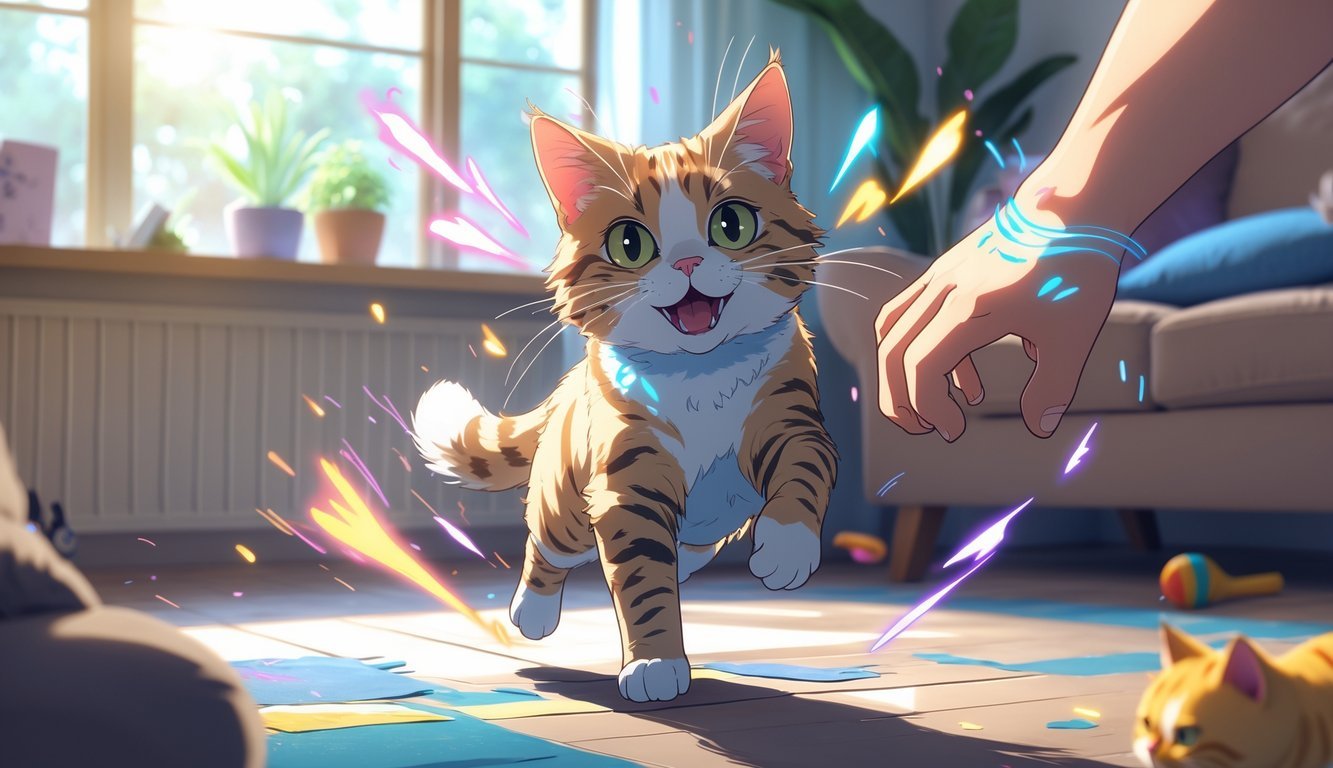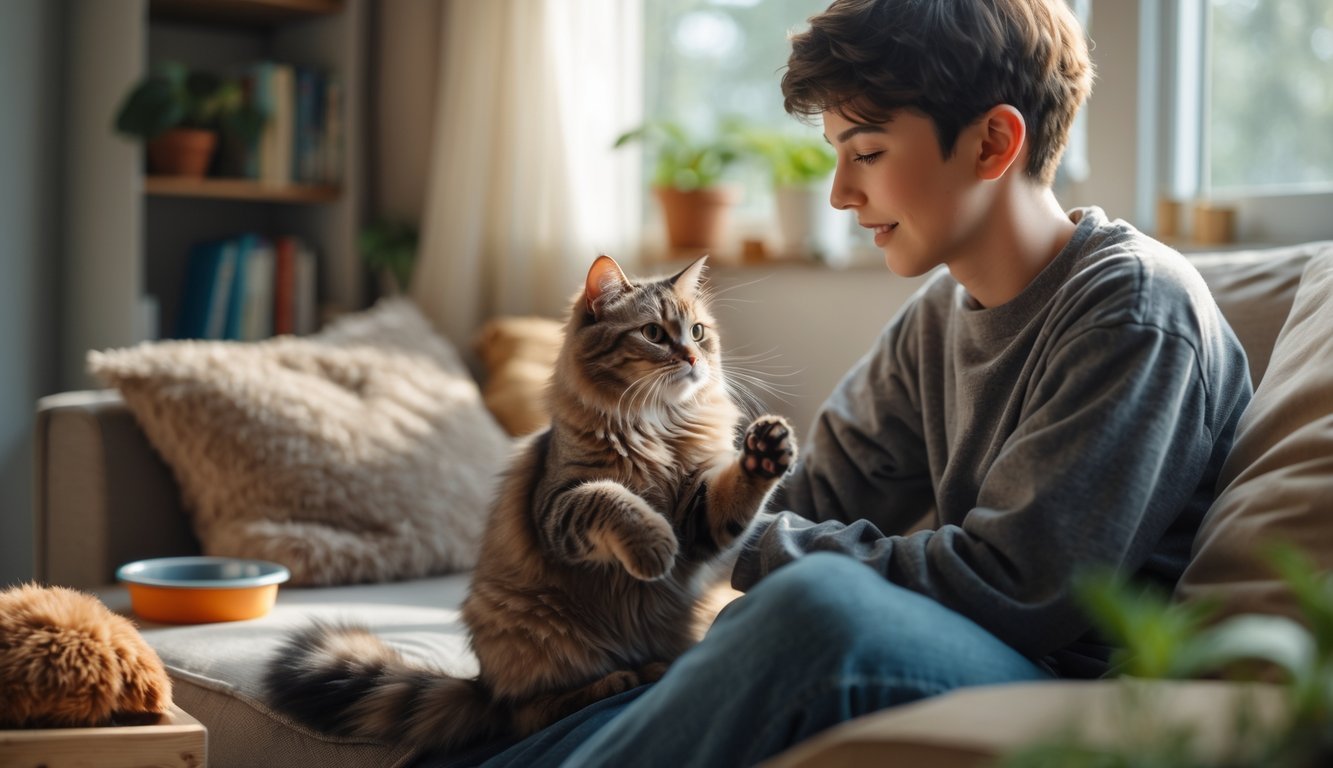PsychNewsDaily Publishers
100 Summit Drive
Burlington, MA, 01803
Telephone: (320) 349-2484
PsychNewsDaily Publishers
100 Summit Drive
Burlington, MA, 01803
Telephone: (320) 349-2484
Cats communicate their needs through vocalizations, body language, and behavior changes, indicating when they seek attention, play, or affection from their owners.

Cats might look independent, but honestly, they rely on a whole bunch of little signals to show when they want you around. If you miss those hints, your cat can get restless—or even act out in ways that throw your home into chaos. Spotting these warning signs helps you figure out what your cat really needs from you.
You’ll catch these signals in all sorts of ways, from sudden behavior changes to bold physical actions that are hard to ignore.
When you learn to notice them, you can respond in a way that makes your cat feel safe and loved.
This usually cuts down on unwanted antics and, honestly, just makes your bond stronger every day.

If your cat starts meowing more than usual, they probably want your attention. Cats use their voices to talk to us—and when they change how much they vocalize, it’s a big clue that they might feel ignored or a little restless.
You might notice your cat trailing you around the house, meowing the whole way. That’s usually a request for interaction—maybe playtime, petting, or just hanging out.
Some cats get loud when they’re bored or feeling lonely, especially if they’re stuck at home by themselves for hours. Tossing them a few toys or setting up a regular play schedule can really help.
Sometimes, the meowing is just about food or treats. But if you’ve already fed them, chances are they’re really asking for your time instead.
If you pay attention to when and how your cat meows, you’ll start to get what they’re after. A little affection and engagement usually calms them down.

When your cat keeps brushing up against you, they’re often asking for your attention. Those scent glands on their cheeks and heads? Rubbing you marks you as part of their safe zone.
If it happens a lot, your cat might be reminding you to spend a little time with them.
You might also spot your cat rubbing on furniture, walls, or doorways. That’s normal marking, but if it’s non-stop, it could mean they’re bored or just need more stimulation.
If your cat shadows you and rubs your legs every time you move, they’re probably signaling that they want play or affection. Even a quick pet or a little chat can make a difference.
Notice when and how often this happens. If it ramps up after you’ve been away or busy, your cat’s likely craving more attention.
Meeting that need tends to cut down on the constant rubbing—and honestly, it’s good for your bond anyway.

If your cat follows you from room to room, they probably want your attention. Maybe they’re just curious about what you’re up to, but it’s often a gentle nudge for interaction.
Some cats just love your company and feel safest when you’re close. It’s a sweet sign of trust.
If your cat starts following you constantly, it could mean they’re bored or need more play. Extra toys or a few short play sessions can help.
Notice if they suddenly start following you more than usual. Sometimes, a big change like that points to stress or even a health issue—worth checking out.
But most of the time, your cat just wants to be part of your day. A little extra time together can go a long way toward making them feel happy and secure.

If your cat suddenly bolts across the room, leaps onto the couch, or just tears around in circles, you’re seeing the classic “zoomies.” These wild bursts are pretty common, but sometimes they’re your cat’s way of saying, “Hey, play with me!”
Cats usually zoom when they’ve got energy to burn. If they’ve been alone or haven’t played in a while, that energy just piles up and comes out all at once.
You might see zoomies after a nap, late at night, or even post-litter box. It’s usually normal, but sometimes it means your cat wants more play and attention from you.
Try adding a few short play sessions with toys or interactive games. Let your cat chase, pounce, and explore with you, and those wild sprints might not happen quite so often.

Scratching is normal for cats—they stretch, sharpen claws, and mark territory that way. But if your cat suddenly starts scratching the couch or chairs more than before, they might be trying to get your attention.
Some cats figure out that scratching the sofa gets a reaction from you—even if it’s just you telling them to stop. So, if they feel ignored, they might keep doing it.
Boredom can also crank up the scratching. If your cat isn’t getting enough play, they’ll look for other ways to burn off energy—and your furniture is an easy target.
You can help by playing with your cat more and putting scratching posts in spots where you hang out together. That way, they can scratch and still feel close to you.
Watch for patterns—if your cat scratches most when you’re busy or distracted, it’s probably time for a little extra bonding.

When your cat paws at your hand or nudges you, they’re usually asking for attention. Maybe they want a head scratch, a gentle pet, or just some acknowledgment.
Cats use their paws and noses to talk to you. That soft tap or nudge is almost never an accident—it’s a pretty clear request for affection.
If you respond with calm petting, your cat knows you get what they’re saying. Sometimes, this also means your cat feels really bonded with you.
They trust you enough to reach out and ask for contact, which is kind of sweet.
Pay attention to their body language while you pet them. If they pull away, flick their tail, or give you a little bite, they’ve probably had enough.
Respecting those signals helps keep your cat feeling safe and your interactions positive.

If your cat curls up to sleep near you, they’re showing they feel safe and want your company. But if they keep waking you up at night, it might mean they’re desperate for more attention.
Cats might wake you by meowing, pawing, or moving around on the bed. Sometimes, they’re just bored or looking for interaction when you’re not available.
When your cat keeps interrupting your sleep, they might not be getting enough play or stimulation during the day. A tired cat is way less likely to wake you up at night.
Try setting a regular play routine before bedtime. Give your cat the attention they want so they’ll settle down easier.
Feeding your cat on a schedule can help too. If they know food comes at certain times, they’re less likely to demand it while you’re sleeping.
If you ignore nighttime attention-seeking, your cat will eventually learn that waking you doesn’t work. It’s tough, but it helps break the habit.
Giving your cat more attention during the day usually cuts down on those late-night wake-up calls, and you’ll still keep that close bond.

Your cat uses body language, sounds, and habits to let you know what they want. If you pay attention to patterns in their actions, you’ll start to tell the difference between normal play and a real plea for your time.
Cats rarely stick to just one signal. They’ll often mix vocal sounds, body posture, and daily routines to get their point across.
For example, you might see a cat meow at the door, rub your leg, and stare you down—all at once.
Watch for small changes. If your cat suddenly starts following you everywhere or paws at your arm, they’re probably asking for attention.
Unlike random play, these moves usually repeat until you notice.
Some cats use physical contact to get your focus. Head-butting, sitting on your laptop, or climbing into your lap—these aren’t accidents.
They’re intentional signals aimed right at you.
When you notice these cues, try gentle petting, a quick play session, or just some calm words. Meeting their needs now can prevent frustration and cut down on stuff like scratching the furniture or meowing up a storm.
Playful behavior is usually all about burning off energy. You’ll see your cat chase toys, pounce on shadows, or zoom around—even if you’re not close by.
Attention-seeking, though, is aimed straight at you. Your cat might tap your arm, meow louder, or plop down right in front of whatever you’re doing.
These actions are less about fun and more about getting a little connection.
Context helps you tell the difference. If your cat drops a toy at your feet, they want to play.
But if they block your keyboard or meow while you’re working, they’re after your attention.
Here’s a quick look:
| Playful Actions | Attention-Seeking Actions |
|---|---|
| Chasing toys or shadows | Pawing at you or things you use |
| Random zoomies | Sitting on your belongings |
| Pouncing on moving objects | Following you closely |
If you notice these patterns, you can respond the right way—whether that’s a play session or just a few minutes of affection.

You can make your relationship with your cat stronger by giving them meaningful interaction and creating a space that fits their natural needs.
A few small daily habits and an enriched home can make a huge difference in how secure and connected your cat feels.
Playtime is probably the easiest way to connect. Try toys that mimic prey—like feather wands or little balls—so your cat can chase, pounce, and “hunt.”
Short sessions of 10–15 minutes a couple times a day help them burn energy and build trust.
Pay attention to what your cat likes. Some go wild for fast movements, others prefer a slower pace. Tweaking your play style shows you get them.
Grooming can be bonding too. Brushing your cat not only helps with shedding, it also mimics how cats show affection to each other.
Even quiet time matters. Just sitting near your cat while you read or watch TV lets them choose closeness on their own terms.
Respecting their space while still being present helps them feel safe.
Tip: Use treats as positive reinforcement during play or training. It creates a clear link between you and good experiences.
Cats really love having spots to climb, hide, and just watch everything. If you set up a tall cat tree, some shelves, or a window perch, you’ll give them safe places to observe the world outside.
Giving them vertical space can make life easier, especially if you’ve got more than one cat around. It just lowers their stress a bit.
Try out interactive toys, like puzzle feeders. These keep your cat’s mind busy and encourage them to figure things out.
Boredom can sneak up and cause all kinds of trouble, so mixing up their toys helps a lot.
Scratching posts? Absolutely necessary. Put them where your cat already likes to hang out—maybe near their favorite nap spot or by a doorway.
That way, they get to stretch and mark their territory without wrecking your furniture.
Change up the toys every week or so. Sometimes, a cardboard box or a crinkly paper bag is just as fun as the fancy stuff from the pet store.
Quick checklist for enrichment:
When you create a home that lets your cat do what comes naturally, they’ll feel more secure—and honestly, you’ll probably feel more connected to them too.